Let’s face it, performance appraisals aren’t everyone’s cup of tea, let alone during a global pandemic.
You may have been wondering, how you’re going to approach it this year?
Should you be a little more lenient because it’s a difficult time? Is this an excuse to delay promotions or pay rises?
Whatever you feel about appraisals this the ideal opportunity to reinforce your support and instigate a little more flexibility in your performance measures.
Everyone is finding the lockdown periods a challenge; with homeschooling, juggling work, looking after elderly relatives and managing tots, every member of your team will be dealing with something different. While no two situations are the same, it would be unfair to use the same performance measures usually used because no-one is at their optimum productivity.
We’ve compiled a shortlist to help you adapt the appraisal process to suit the current climate.
- Increase the frequency of appraisals and 1-2-1 contact
Rather than holding employee reviews once a year, it could prove prudent to have more regular contact with each employee at the current time. Now, I know it appears to be more time-consuming to host an individual meeting with every person more often, but it’s proven to save you time and money, due to increased productivity, improved staff morale and employee engagement. - Keep it positive, constructive and performance-related, never personal or negative.
This is the time to encourage, support and engage with your staff, not to berate them. Working remotely can bring rise to feelings of isolation, loneliness and fears of anxiety. You never know what someone is going through, so take it gently, kindly and slowly uncover what’s going on and find strategies to work together and move forwards. - Make clear and decisive recommendations on how you’d like your employees to improve.
Assertive behaviours can help people gain a sense of security and leadership by demonstrating that the person in charge is in control. With all the uncertainty around, it’s a good time to show that clear and focused strategies will enable everyone to move forward productively and positively. - Offer training, mentoring or job shadowing (if possible) to support your employees in the future.
Whether staff are furloughed, at the office, factory, or working from home, there are still many personal and professional development opportunities. Both parties’ benefits are numerous and can help align employee and business goals for long-term growth. - Maintain an open-door policy.
Even in those that never suffered previously, anxiety levels are exaggerated when working in isolation and away from your workplace team. Create a relaxed yet professional approach to creating opportunities for employees to follow up with you, ask for feedback and discuss alternatives if their current situations are unworkable.
Like everything this past year, we must do things a little differently, but who knows maybe this change will be for the better as we advance.
Technology is a great addition to keeping communications fluid and ongoing, but don’t forget to remind all staff members to take regular breaks, get some fresh air and keep talking to one another. It’s also important to remain mindful of mental health issues. As the leader; it’s your responsibility to look out for warning signs that your staff may be struggling. If performance is dipping, and behaviour is poor then maybe there is more to the issue than simply laziness or excuses. Struggling with your mental health can manifest itself in many forms, so keep talking, evaluating, and keep appraising.
